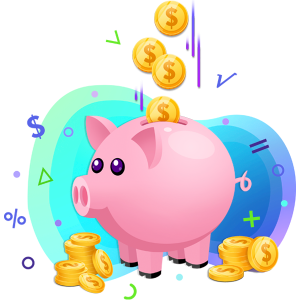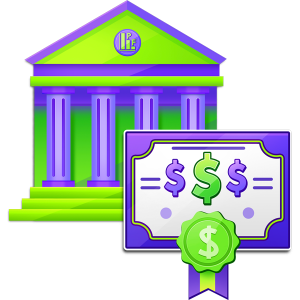1-02 Basic Bank Accounts
Bank accounts are issued by banks, credit unions, and savings & loan institutions as a secure way to store your money and make it easily accessible later (without carrying around all your cash everywhere you go). If you are sitting with your first $500, you usually have two options for accounts: a Savings Account, or a Checking Account.
Before we get into how to make money through your bank, we first need to understand how a bank makes its money off YOU.

How Banks Make Their Money
Historically, banks made their money by issuing loans. They loan out money to people and charge them interest, and the interest on those loans made money for the bank.
However, if a bank is going to make loans, they need money to loan out. This is where the first Bank Accounts came from – attracting people to give their money to the bank, so they can loan it out and earn a profit. People did not want to just hand over their money to banks for free though, so banks advertised some specific perks on why you should give them your money:
- More secure. If you keep all of your cash at home, someone could break in and steal it. Banks are much harder to rob than your apartment.
- They pay you for it. Banks also pay you interest on money you store with them, paid out of the interest they charge people who borrow that money.
In this case, both you and the bank get a good deal – they get paid interest when they issue loans, and they give you some of that interest as thanks for letting them use your money.
Wealth Management

In recent years, banks do a lot more business than just issue loans. There is an entire world of “Wealth Management” products that banks offer – helping people invest their money, creating and selling mutual funds, and much more. This is often more profitable than just issuing loans and does not require people to store their money at the bank to sell it.
Both sides (usually) get a good deal here too. People who want to invest (but are not comfortable investing on their own) have expert help, and the bank can pool the assets of many savers to make bigger investments and earn better returns.
Now that we have some idea of how banks make THEIR money, we can see how they can make YOU money.
Bank Account Types
The two most common types of bank accounts are Checking Accounts and Savings Accounts. There are also other types (like Certificates of Deposit and Money Market Accounts) that we will cover in later chapters.
Checking Accounts
Checking accounts are the type of bank account you would use for regular purchases. Originally just for “writing checks”, checking accounts are tied to your debit card, and can be used for paying bills online.
This means most people do not keep very much money in their checking account – and so banks do not use this money to issue loans to other people. But that does not mean banks offer checking accounts just out of the goodness of their heart – they still need to make money! Instead, they use checking accounts to make money through:
- Charging user fees. Many banks may charge an annual fee for your checking account (usually less than $100). This annual fee may be waived if you keep a minimum balance (so they can use this money to issue loans).
- Upselling. If you have a checking account at a bank, and they see you are starting to grow your account balances, the bank will usually try to convince you to open a savings account or use some of their wealth management services. If you need a mortgage or other loan, the first place you look is probably where you are already banking. This is the main way banks make money from people with checking accounts.
“Upselling” is becoming more and more important to bank’s business model. Many banks offer Free Checking Accounts, or even pay you a small amount of interest on your checking account, just so they will be the first place you look when you need a loan or wealth management services.
Savings Accounts
Savings accounts are the oldest type of bank account – the bank wants you to save your money in a Savings Account, they loan it to other people, and pay you interest on your savings. Savings accounts are meant for medium- to long-term savings. This is because banks need stable deposits in order to issue loans – they cannot loan out money if everyone tries to empty their savings account every month.
To encourage long-term savings (and so more money available for them to lend out), banks usually offer higher interest rates if you can keep more cash sitting in your account for longer periods of time.

| Balance required | Interest rate |
| $0 | 0.05% |
| $10,000 | 0.25% |
| $25,000 | 0.75% |
The more you keep deposited, the more you earn – but even the highest amount is still not very much interest. Even so, when you think about investing, your Savings Account is the most basic option.
Risk Vs Reward
This is a key aspect of investing – Risk versus Reward. If you have less than $250,000 in your savings account, it has protection from the FDIC (a federal agency set up to insure bank accounts at no cost to savers). This means that putting your money into a savings account has almost no risk – but the interest rate is so low, there is also very little reward.
Note: FDIC protection only applies to deposits made at approved financial institutions – like banks, credit unions, and savings & loan institutions. Mobile pay accounts (unless offered by a bank) and cryptocurrency wallets do not offer this type of protection, putting your deposits at risk.
Liquidity
There is one more key concept to learn from Checking and Savings accounts when it comes to investing – Liquidity. “Liquidity” means how fast you can convert your investment to cash if you need to spend it. The more “Liquid” the asset, the lower reward you can expect.
If you want to earn more interest in your savings account, you need to “lock up” more cash that you cannot withdraw or spend. Checking accounts pay no (or very little) interest, but you can spend it whenever you want.
For all other investment types, keep this balance in mind – Less Liquid and More Risk usually has bigger rewards. More Liquid and Less Risk usually has the lowest rewards.